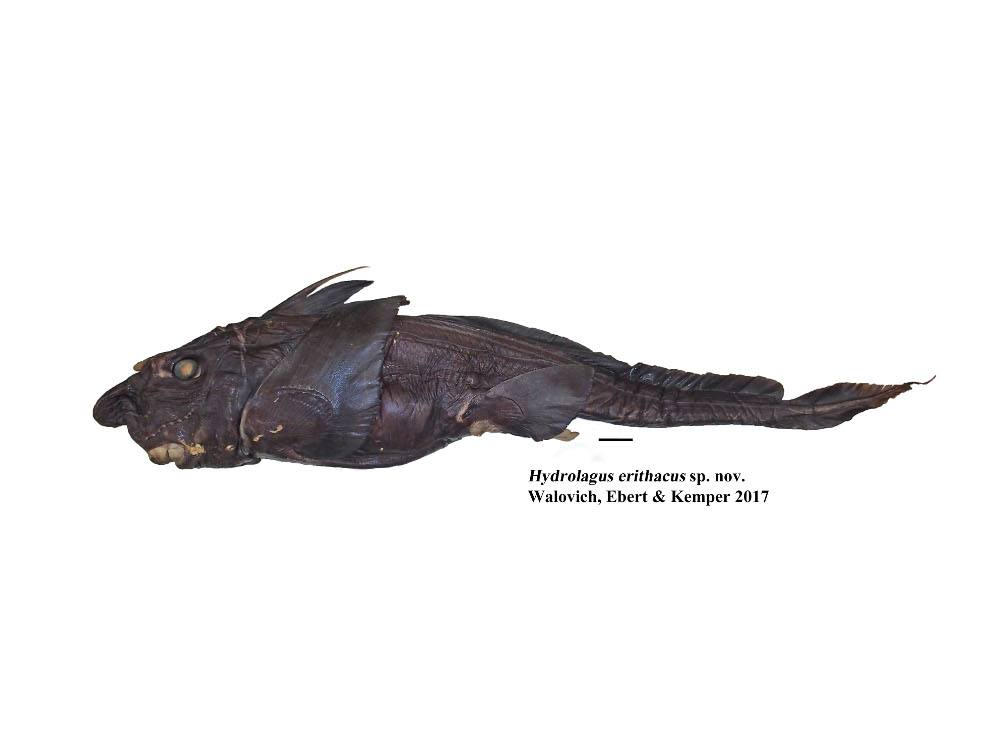Hydrolagus erithacus
Walovich, Ebert & Kemper, 2017
Robin’s Ghostshark
Classification: Holocephali Chimaeriformes Chimaeridae
Reference of the original description
Hydrolagus erithacus sp. nov. (Chimaeriformes: Chimaeridae), a new species of chimaerid from the southeastern Atlantic and southwestern Indian oceans. Zootaxa, 4226(4), 509–520
Hydrolagus erithacus sp. nov. (Chimaeriformes: Chimaeridae), a new species of chimaerid from the southeastern Atlantic and southwestern Indian oceans. Zootaxa, 4226(4), 509–520
Types
Hydrolagus erithacus
Holotype: SAIAB: 200578; Paratype: SAIAB: 200579; SAM: 34432; SAM: 34434; SAM: 34723; SAM: 35442; SAM: 34724; SAM: 35446; SAM: 35447;
Hydrolagus erithacus
Holotype: SAIAB: 200578; Paratype: SAIAB: 200579; SAM: 34432; SAM: 34434; SAM: 34723; SAM: 35442; SAM: 34724; SAM: 35446; SAM: 35447;
Description :
Citation: Hydrolagus erithacus Walovich, Ebert & Kemper, 2017: In: Database of modern sharks, rays and chimaeras, www.shark-references.com, World Wide Web electronic publication, Version 01/2026
Please send your images of "Hydrolagus erithacus" to info@shark-references.com

Hydrolagus erithacus Walovich, Ebert & Kemper, 2017, holotype, SAIAB 200578, mature male, 1290 mm TL, 790 mm BDL, Scale bar = 5 cm © Kristin Walovich

Hydrolagus erithacus Walovich, Ebert & Kemper, 2017, holotype, SAIAB 200578, mature male, 1290 mm TL, 790 mm BDL, Scale bar = 5 cm © Kristin Walovich
Common names
 Robin’s Ghostshark
Robin’s Ghostshark
 Robin’s Ghostshark
Robin’s Ghostshark
Short Description
Original Diagnosis of WALOVICH, EBERT & KEMPER, 2017 [25062]: Hydrolagus erithacus is a large species at maturity (765–945 mm BDL) distinguished from all other congeners based on the following combination of characters: head bulky, large followed by stocky body, height similar from about pectoral fin origins to pelvic fin origins remaining consistent in height until the insertion of the pelvic fins, tall dorsal spine greater in height than first dorsal fin. Second dorsal fin up to 81% of total body length, uniform in height, and equal to dorsal caudal fin height. Paired claspers trifurcate, forked for approximately 20% of total length with fleshy, bulbous tips. Prepelvic tenaculae with five to seven medial spines and thick frontal tenaculum, nearly uniform in width. Coloration after preservation uniform black with no distinct markings. Comparison of mitochondrial NADH2 gene sequences with other related species suggests a distinct lineage.
Original Diagnosis of WALOVICH, EBERT & KEMPER, 2017 [25062]: Hydrolagus erithacus is a large species at maturity (765–945 mm BDL) distinguished from all other congeners based on the following combination of characters: head bulky, large followed by stocky body, height similar from about pectoral fin origins to pelvic fin origins remaining consistent in height until the insertion of the pelvic fins, tall dorsal spine greater in height than first dorsal fin. Second dorsal fin up to 81% of total body length, uniform in height, and equal to dorsal caudal fin height. Paired claspers trifurcate, forked for approximately 20% of total length with fleshy, bulbous tips. Prepelvic tenaculae with five to seven medial spines and thick frontal tenaculum, nearly uniform in width. Coloration after preservation uniform black with no distinct markings. Comparison of mitochondrial NADH2 gene sequences with other related species suggests a distinct lineage.
Distribution
southeastern Atlantic and southwestern Indian oceans, between latitudes 39° to 47° S [25062] Source: www.gbif.org
southeastern Atlantic and southwestern Indian oceans, between latitudes 39° to 47° S [25062] Source: www.gbif.org
Size / Weight / Age
TL/BDL max: 945 mm BDL, 1405 mm TL. TL/BDL min (mature): 842 mm and 765 mm BDL [25062]
TL/BDL max: 945 mm BDL, 1405 mm TL. TL/BDL min (mature): 842 mm and 765 mm BDL [25062]
Remarks
shark-references Species-ID=14839;
shark-references Species-ID=14839;

















